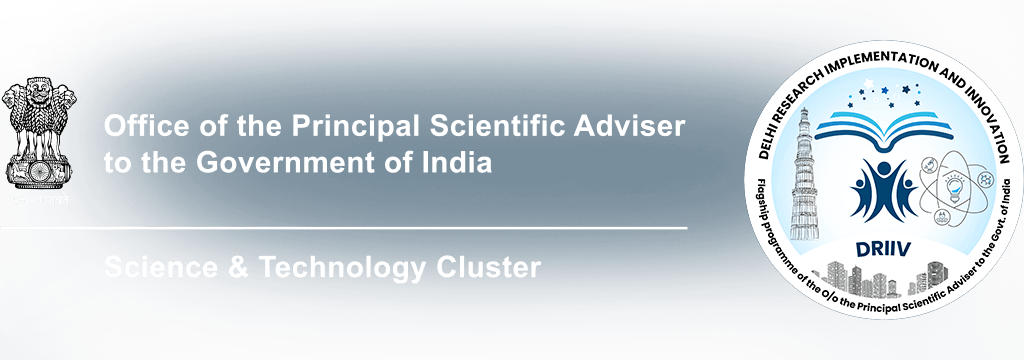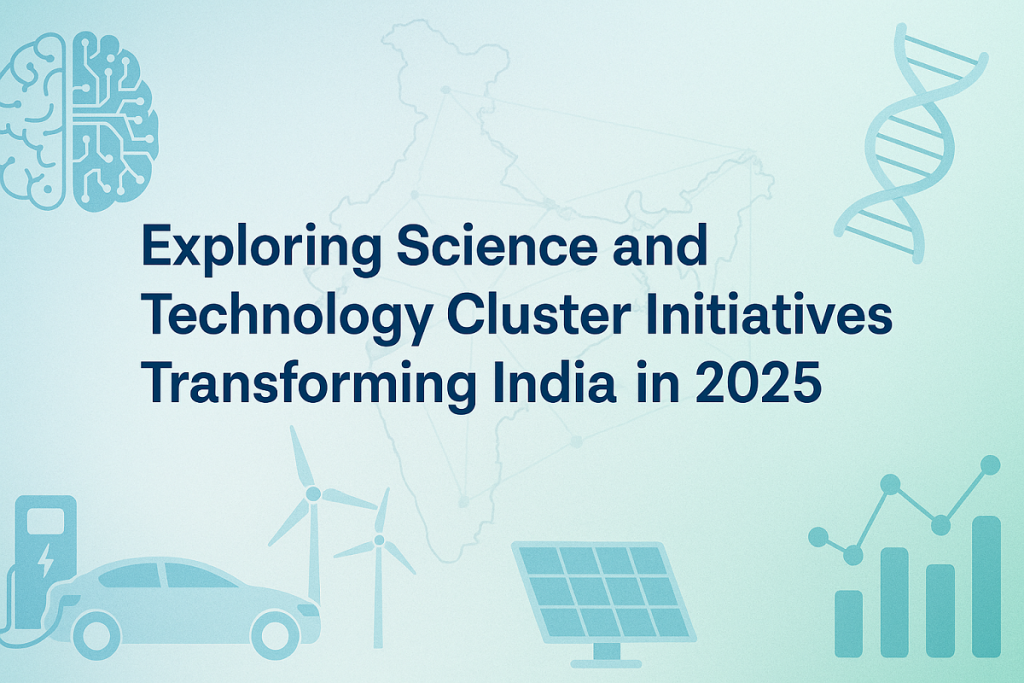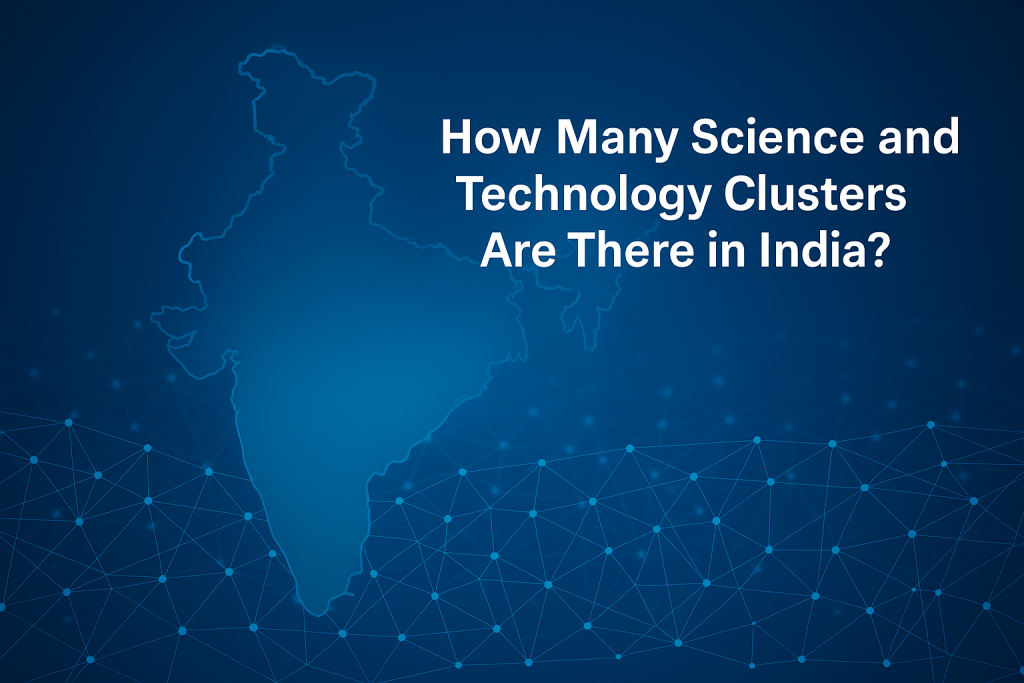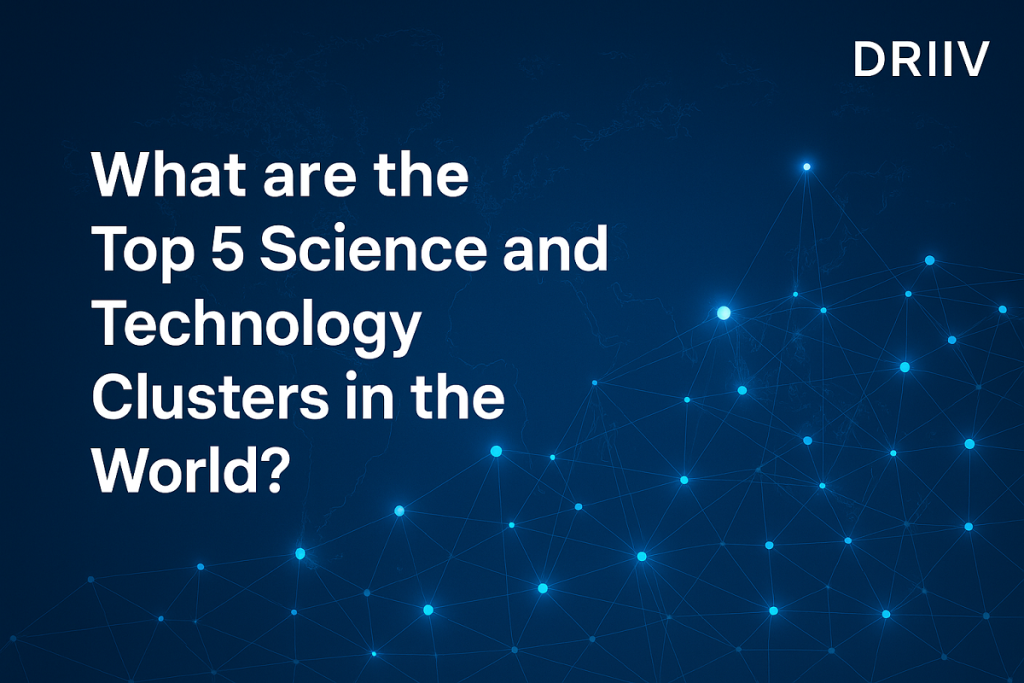India in 2025 stands at the crossroads of rapid development, where innovation and collaboration are reshaping its economic, environmental, and technological future. One of the most impactful developments in recent years is the rise of Science and Technology Cluster initiatives. These S&T Clusters are powering innovation, building local capabilities, and driving India’s journey toward AtmaNirbhar Bharat.
At the heart of this transformation are sustainable technology solutions, research-driven collaborations, and a shared vision for a better future. In this blog, we’ll explore how Science and Technology Cluster models are changing the face of India in 2025, and how they are promoting science for sustainability.
What is a Science and Technology Cluster?
A S&T Cluster is a regional innovation ecosystem where research institutions, universities, industries, startups, and government agencies come together to work on common challenges. These clusters promote the exchange of knowledge, technology, and expertise. They bridge the gap between science and society, making research useful, accessible, and impactful.
In India, S&T Clusters are not just about innovation—they are about solving real-world problems such as pollution, health, water scarcity, and energy challenges. They bring together the best minds and institutions to co-create sustainable technology solutions tailored to the needs of the country.
Why Are S&T Clusters Important for India in 2025?
1. Accelerating Innovation
In 2025, India is competing globally in sectors like biotech, clean energy, space, and semiconductors. S&T Clusters allow faster research-to-market cycles. They enable idea exchange and collaborative prototyping that can lead to breakthroughs much quicker than isolated efforts.
2. Building AtmaNirbhar Bharat
The vision of AtmaNirbhar Bharat—a self-reliant India—can only be achieved if science, technology, and industry work hand in hand. Science and Technology Clusters support this by fostering indigenous technologies, reducing dependence on imports, and boosting local manufacturing.
3. Promoting Sustainable Development
In the face of climate change and resource depletion, sustainable technology solutions are the need of the hour. S&T Clusters focus on science for sustainability, addressing issues like air pollution, waste management, clean water, and green energy.
DRIIV: A Leading S&T Cluster Transforming Delhi-NCR
One shining example of this model is DRIIV (Delhi Research Implementation and Innovation), a flagship Science and Technology Cluster under the Office of the Principal Scientific Adviser to the Government of India.
DRIIV is leading initiatives across Delhi-NCR to solve real challenges through scientific collaboration and innovation. Its work covers sectors like:
- Air Pollution Mitigation
- Water Security
- Sustainable Mobility
- Waste Management
- Healthcare Technologies
- Green Energy Solutions
By connecting premier institutes like IIT Delhi, AIIMS, IIIT-Delhi, and more, DRIIV is fostering an environment of knowledge-driven change.
Key Initiatives Driving Impact in 2025
Let’s look at some of the impactful projects from Science and Technology Clusters like DRIIV that are shaping India in 2025.
1. Smart Air Pollution Control Systems
Through tech-enabled interventions such as low-cost sensors, smog towers, and AI-based data analysis, clusters are tackling air pollution across Delhi-NCR and beyond.
2. Clean Water and Wastewater Management
Projects using sustainable technology solutions like phycoremediation, nano-filtration, and decentralized water treatment units are providing clean and safe water to communities.
3. Green Mobility & EV Support
S&T Clusters support India’s push for Green Mobility by promoting EV infrastructure, battery research, and policy integration, directly contributing to the Green Energy Transition.
4. Science for Sustainability in Agriculture
Clusters are using satellite imaging, IoT, and AI to improve farming methods, reduce pesticide use, and promote sustainable agriculture.
5. Healthcare Technology & Pandemic Preparedness
From portable diagnostics to remote health monitoring, innovations born in S&T Clusters are improving rural and urban healthcare systems in 2025.
Role of S&T Clusters in Realizing AtmaNirbhar Bharat
The AtmaNirbhar Bharat mission is not just about being self-reliant—it’s about being globally competitive with local strength. Science and Technology Clusters play a key role by:
- Developing Indigenous Technologies
Building solutions in India for Indian challenges.
- Encouraging Startups and MSMEs
Clusters provide incubation support, research access, and funding for small enterprises.
- Skilling the Workforce
Industry-academia partnerships create opportunities for training and employment in high-tech sectors.
- Fostering Inclusive Growth
Innovation reaches every corner of the country, from urban metros to remote villages.
Science for Sustainability: The Future We Need
India’s development cannot be at the cost of its environment. Science for Sustainability means creating growth that’s eco-friendly, socially inclusive, and future-ready.
Here’s how S&T Clusters are promoting sustainability in 2025:
- Clean Energy Research – Solar, wind, and hydrogen solutions.
- Circular Economy – Recycling waste into usable products.
- Carbon Capture Technologies – Reducing greenhouse gas emissions.
- Smart Cities – Digital infrastructure for energy and water efficiency.
These efforts ensure that India’s progress doesn’t harm the planet, but protects it for future generations.
Benefits of Science and Technology Clusters
| Benefit | Impact in 2025 |
| Faster Innovation | Research becomes solutions quickly |
| Industry-Academia Link | Real-world applications of scientific research |
| Local Problem Solving | Focus on India’s unique challenges |
| Employment Generation | Jobs in tech, R&D, manufacturing, and services |
| Sustainable Growth | Balancing economy with environmental responsibility |
| Knowledge Ecosystem | Continuous learning, mentorship, and innovation culture |
How DRIIV is Driving Change in 2025
At DRIIV, we believe in research that reaches people. Our projects are chosen based on societal needs and scientific feasibility. In 2025, we continue to:
- Connect stakeholders from government, academia, and industry.
- Enable real-world pilot projects in urban and rural settings.
- Scale successful models for national deployment.
- Promote awareness on sustainability and innovation.
Whether it’s transforming urban mobility or treating wastewater in rural India, our mission is to transform science into service.
The Way Forward
India’s journey to becoming a global innovation leader depends on how we scale and support Science and Technology Clusters. With the right investments, policies, and partnerships, these clusters will continue to solve national challenges while contributing to global goals.
By 2030, the impact of today’s clusters will be visible in cleaner air, smarter cities, empowered youth, and a resilient economy. That’s the power of science for sustainability and the strength of AtmaNirbhar Bharat.
FAQs
1. What is a Science and Technology Cluster?
A Science and Technology Cluster is a network of research institutions, industries, startups, and government bodies working together to solve challenges through innovation and collaboration.
2. How do S&T Clusters support AtmaNirbhar Bharat?
S&T Clusters promote self-reliance by developing local technologies, supporting startups, and reducing dependency on foreign innovation.
3. What is DRIIV, and what does it do?
DRIIV is a leading Science and Technology Cluster in Delhi-NCR that focuses on solving regional challenges using science-based solutions in sectors like health, water, pollution, and mobility.
4. What are some examples of sustainable technology solutions developed in clusters?
Solutions include clean water systems, EV infrastructure, air purification units, smart farming tools, and renewable energy systems.
5. How can startups benefit from S&T Clusters?
Startups gain access to research facilities, mentorship, funding, and market linkages to help them scale and succeed.
6. What is meant by science for sustainability?
Science for sustainability refers to using research and technology to promote long-term environmental balance, economic growth, and social welfare.
Conclusion
India is transforming, and at the heart of this change are Science and Technology Clusters like DRIIV. In 2025, these clusters are delivering sustainable technology solutions, enabling science for sustainability, and building the foundation of a truly AtmaNirbhar Bharat.
As we move forward, supporting and scaling these clusters will be essential for building a future that is innovative, inclusive, and environmentally responsible. At DRIIV, we remain committed to using science to serve society—and to make India a leader in sustainable innovation.




